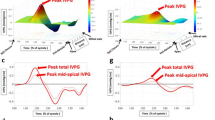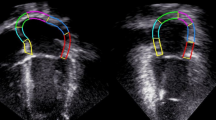Abstract
Cardiac dysfunction due to cardiotoxicity from anthracycline chemotherapy is a leading cause of morbidity and mortality in survivors of childhood cancer. The intraventricular pressure gradient (IVPG) of the left ventricle (LV) is the suction force of blood from the left atrium to the LV apex during early diastole and is a sensitive indicator of diastolic function. We assessed IVPG as a new indicator of the cardiac dysfunction in survivors of childhood cancer after anthracycline therapy. We performed a prospective echocardiographic study on 40 survivors of childhood cancer aged 6–26 years who received anthracycline therapy (group A) and 53 similar-age normal controls (group N). The subjects were divided into the younger groups, N1 and A1 (age < 16 years); older groups, N2 and A2 (age ≥ 16 years). IVPG was calculated using color M-mode Doppler imaging of the mitral inflow using Euler’s equation. Total IVPG was divided into the basal and mid-to-apical IVPG to demonstrate more clearly the mechanisms of the LV diastolic suction force. The total anthracycline dose was 16.2–600.0 mg/m2 (median 143.5 mg/m2). Total IVPG significantly decreased in group A2 compared with that in group N2 (0.39 ± 0.07 vs. 0.29 ± 0.11 mmHg/cm; p = 0.010). The mid-to-apical IVPG significantly decreased in groups A1 and A2 compared with that in groups N1 and N2, respectively (N1 vs. A1: 0.20 ± 0.05 vs. 0.16 ± 0.05 mmHg/cm, p = 0.036; N2 vs. A2: 0.21 ± 0.06 vs. 0.14 ± 0.06 mmHg/cm, p = 0.001). Basal IVPG, E wave, and E/e′ were not significantly different between patients and normal controls. The total and mid-to-apical IVPG, especially mid-to-apical IVPG, could be sensitive new indicators in survivors of childhood cancer after anthracycline therapy.


Similar content being viewed by others
References
van der Pal HJ, van Dalen EC, van Delden E, van Dijk IW, Kok WE, Geskus RB, Sieswerda E, Oldenburger F, Koning CC, van Leeuwen FE, Caron HN, Kremer LC (2012) High risk of symptomatic cardiac events in childhood cancer survivors. J Clin Oncol 30:1429–1437
Kremer LC, van Dalen EC, Offringa M, Ottenkamp J, Voûte PA (2001) Anthracycline-induced clinical heart failure in a cohort of 607 children: long-term follow-up study. J Clin Oncol 19:191–196
Reulen RC, Winter DL, Frobisher C, Lancashire ER, Stiller CA, Jenney ME, Skinner R, Stevens MC, Hawkins MM; British Childhood Cancer Survivor Study Steering Group (2010) Long-term cause-specific mortality among survivors of childhood cancer. JAMA 304:172–179
Felker GM, Thompson RE, Hare JM, Hruban RH, Clemetson DE, Howard DL, Baughman KL, Kasper EK (2000) Underlying causes and long-term survival in patients with initially unexplained cardiomyopathy. N Engl J Med 342:1077–1084
Thavendiranathan P, Poulin F, Lim KD, Plana JC, Woo A, Marwick TH (2014) Use of myocardial strain imaging by echocardiography for the early detection of cardiotoxicity in patients during and after cancer chemotherapy: a systematic review. J Am Coll Cardiol. 63:2751–2768
Cardinale D, Colombo A, Lamantia G, Colombo N, Civelli M, De Giacomi G, Rubino M, Veglia F, Fiorentini C, Cipolla CM (2010) Anthracycline-induced cardiomyopathy: clinical relevance and response to pharmacologic therapy. J Am Coll Cardiol 55:213–220
Cheung YF, Hong WJ, Chan GC, Wong SJ, Ha SY (2010) Left ventricular myocardial deformation and mechanical dyssynchrony in children with normal ventricular shortening fraction after anthracycline therapy. Heart 96:1137–1141
Poterucha JT, Kutty S, Lindquist RK, Li L, Eidem BW (2012) Changes in left ventricular longitudinal strain with anthracycline chemotherapy in adolescents precede subsequent decreased left ventricular ejection fraction. J Am Soc Echocardiogr 25:733–740
Negishi K, Negishi T, Haluska BA, Hare JL, Plana JC, Marwick TH (2014) Use of speckle strain to assess left ventricular responses to cardiotoxic chemotherapy and cardioprotection. Eur Heart J Cardiovasc Imaging 15:324–331
Grossman W (1990) Diastolic dysfunction and congestive heart failure. Circulation 81: III1–III7
Nagueh SF, Appleton CP, Gillebert TC, Marino PN, Oh JK, Smiseth OA, Waggoner AD, Flachskampf FA, Pellikka PA, Evangelista A (2009) Recommendations for the evaluation of left ventricular diastolic function by echocardiography. J Am Soc Echocardiogr 22:107–133
Armstrong GT, Joshi VM, Ness KK, Marwick TH, Zhang N, Srivastava D, Griffin BP, Grimm RA, Thomas J, Phelan D, Collier P, Krull KR, Mulrooney DA, Green DM, Hudson MM, Robison LL, Plana JC (2015) Comprehensive echocardiographic detection of treatment-related cardiac dysfunction in adult survivors of childhood cancer: results from the St. Jude Lifetime Cohort Study. J Am Coll Cardiol 65:2511–2522
Nikolic SD, Feneley MP, Pajaro OE, Rankin JS, Yellin EL (1995) Origin of regional pressure gradients in the left ventricle during early diastole. Am J Physiol 268:H550–H557
Firstenberg MS, Smedira NG, Greenberg NL, Prior DL, McCarthy PM, Garcia MJ, Thomas JD (2001) Relationship between early diastolic intraventricular pressure gradients, an index of elastic recoil, and improvements in systolic and diastolic function. Circulation 104:I330–335
Popović ZB, Richards KE, Greenberg NL, Rovner A, Drinko J, Cheng Y, Penn MS, Fukamachi K, Mal N, Levine BD, Garcia MJ, Thomas JD (2006) Scaling of diastolic intraventricular pressure gradients is related to filling time duration. Am J Physiol Heart Circ Physiol 291:H762–H769
Takahashi K, Nii M, Takigiku K, Toyono M, Iwashima S, Inoue N, Tanaka N, Matsui K, Shigemitsu S, Yamada M, Kobayashi M, Yazaki K, Itatani K, Shimizu T (2018) Development of suction force during early diastole from the left atrium to the left ventricle in infants, children, and adolescents. Heart Vessels (online). https://doi.org/10.1007/s00380-018-1239-9
Takayasu H, Takahashi K, Takigiku K, Yasukochi S, Furukawa T, Akimoto K, Kishiro M, Shimizu T (2011) Left ventricular torsion and strain in patients with repaired tetralogy of Fallot assessed by speckle tracking imaging. Echocardiography 28:720–729
Yazaki K, Takahashi K, Shigemitsu S, Yamada M, Iso T, Kobayashi M, Akimoto K, Tamaichi H, Fujimura J, Saito M, Nii M, Shimizu T (2018) In-depth insight into the mechanisms of cardiac dysfunction in patients with childhood cancer after anthracycline treatment using layer-specific strain analysis. Circ J 82:715–723
Greenberg NL, Vandervoort PM, Firstenberg MS, Garcia MJ, Thomas JD (2001) Estimation of diastolic intraventricular pressure gradients by Doppler M-mode echocardiography. Am J Physiol Heart Circ Physiol 280:H2507–H2515
Kobayashi M, Takahashi K, Yamada M, Yazaki K, Matsui K, Tanaka N, Shigemitsu S, Akimoto K, Kishiro M, Nakanishi K, Kawasaki S, Nii M, Itatani K, Shimizu T (2017) Assessment of early diastolic intraventricular pressure gradient in the left ventricle among patients with repaired tetralogy of Fallot. Heart Vessels 32:1364–1374
Ohara T, Niebel CL, Stewart KC, Charonko JJ, Pu M, Vlachos PP, Little WC (2012) Loss of adrenergic augmentation of diastolic intra-LV pressure difference in patients with diastolic dysfunction: evaluation by color M-mode echocardiography. JACC Cardiovasc Imaging 5:861–870
Iwano H, Kamimura D, Fox E, Hall M, Vlachos P, Little WC (2015) Altered spatial distribution of the diastolic left ventricular pressure difference in heart failure. J Am Soc Echocardiogr 28:597–605
Steine K, Stugaard M, Smiseth OA (1999) Mechanisms of retarded apical filling in acute ischemic left ventricular failure. Circulation 99:2048–2054
Yu HK, Yu W, Cheuk DK, Wong SJ, Chan GC, Cheung YF (2013) New three-dimensional speckle-tracking echocardiography identifies global impairment of left ventricular mechanics with a high sensitivity in childhood cancer survivors. J Am Soc Echocardiogr 26:846–852
Wang J, Kurrelmeyer KM, Torre-Amione G, Nagueh SF (2007) Systolic and diastolic dyssynchrony in patients with diastolic heart failure and the effect of medical therapy. J Am Coll Cardiol 49:88–96
Lipshultz SE, Lipsitz SR, Mone SM, Goorin AM, Sallan SE, Sanders SP, Orav EJ, Gelber RD, Colan SD (1995) Female sex and higher drug dose as risk factors for late cardiotoxic effects of doxorubicin therapy for childhood cancer. N Engl J Med 332:1738–1743
Zamorano JL, Lancellotti P, Rodriguez Muñoz D, Aboyans V, Asteggiano R, Galderisi M, Habib G, Lenihan DJ, Lip GYH, Lyon AR, Lopez Fernandez T, Mohty D, Piepoli MF, Tamargo J, Torbicki A, Suter TM; ESC Scientific Document Group (2016) 2016 ESC Position Paper on cancer treatments and cardiovascular toxicity developed under the auspices of the ESC Committee for Practice Guidelines: the Task Force for cancer treatments and cardiovascular toxicity of the European Society of Cardiology (ESC). Eur Heart J 37:2768–2801
Acknowledgements
We thank the staff of Shizuoka Children’s Hospital for collecting the echocardiographic data of children and adults with no cardiac defects (healthy group).
Author information
Authors and Affiliations
Corresponding author
Ethics declarations
Conflict of interest
This research did not receive any specific grant from funding agencies in the public, commercial, or not-for-profit sectors.
Additional information
Publisher's Note
Springer Nature remains neutral with regard to jurisdictional claims in published maps and institutional affiliations.
Electronic supplementary material
Below is the link to the electronic supplementary material.
Rights and permissions
About this article
Cite this article
Shigemitsu, S., Takahashi, K., Yazaki, K. et al. New insight into the intraventricular pressure gradient as a sensitive indicator of diastolic cardiac dysfunction in patients with childhood cancer after anthracycline therapy. Heart Vessels 34, 992–1001 (2019). https://doi.org/10.1007/s00380-018-01332-7
Received:
Accepted:
Published:
Issue Date:
DOI: https://doi.org/10.1007/s00380-018-01332-7




